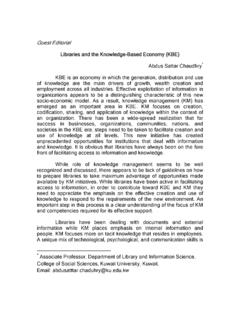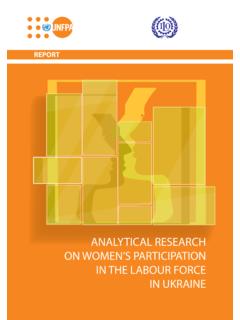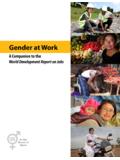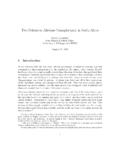Transcription of The Socio-Economic and Demographic …
1 351 South Asian Studies A Research Journal of South Asian Studies Vol. 24, No. 2, July 2009, pp. 351-367 The Socio-Economic and Demographic Determinants of Women Work participation in Pakistan: Evidence from Bahawalpur District Muhammad Zahir Faridi Bahauddin Zakariya University, Multan Imran Sharif Chaudhry Bahauddin Zakariya University, Multan Mumtaz Anwar University of the Punjab, Lahore ABSTRACT The analysis of labour market participation is useful for formulating employment and human resource development policies. Females form almost more than half of the total population in Pakistan play a very important role in the country. The present study endeavors to estimate the various factors which affect the women work participation . The study is based on the cross-section data collected through field survey. The logistic regression technique is employed to estimate the determinants of female labour force participation .
2 Educational attainment levels turn out to be very significant determinant. Female s labour force participation rises with increasing level of education. Presence of children in early age groups reduces the female labour force participation . The results of the study conclude that female education is necessary for better employment opportunities. KEY WORDS: Female labor force participation ; Female education; Household Income; Family Dependents; Marital Status; Children; Logit Model; Pakistan Introduction The labour force participation rate plays a very essential role in determining Socio-Economic development and growth. It also has a strong bearing effect on poverty M. Zahir Faridi, Imran Sharif Ch. & Mumtaz Anwar The Socio-Economic 352 reduction. The labour force participation rate shows the supply of labour in the economy and the composition of the human resources of the country. The analysis of the labour force participation is helpful in determining employment policy and policy formulation for human resource development.
3 Females constitute about half of the total population in Pakistan and play a very significant role in the economy. The trend and structure of the female labour force participation (FLFP) has attracted attention over the past few decades in the world and from the past few years in the Pakistan. The incidence of women work participation is low in Pakistan. Although the average annual growth rate of women work participation is rising slightly in Pakistan, which was percent during the period 2003-04 and has gone up to during the period 2005-061. But still women work participation is very low as compared to the south Asian countries. This study is an effort to identify the Socio-Economic and Demographic factors which determine the women work participation . This issue has been analyzed in many studies2 but these studies have been generally failed to incorporate various Socio-Economic and Demographic variables in their analysis.
4 In the present study, we have attempted to analyze the relationship of age profile of the women and all levels of education with work participation of the females in some detail. The study is planned into five sections. Introduction is presented in the first section. The second section provides the review of literature. In the third section, we have discussed methodology, data sources and variables. The results of the estimation are presented in the fourth section. We have offered some concluding remarks and policy implications in the last section. Literature Review Literature review on labor force participation and supply of labor both at national and international level is discussed in this section. A number of studies can be observed in the literature relating to the economic theory of the household. Becker (1965) and Gronau (1977) is the beginner of the field and explained the household behavior regarding time allocation.
5 However, a vast variety of literature based on empirical studies especially for developed nations is available. Most of them are survey based and these surveys are carried by Macurdy, Heckman (1980) and Heckman and Killingworth (1986). Mincer (1962) has discussed the relationship between working hours and female labor force participation overtime. He has explored that wife s demand for leisure is not influenced by income of the family. The probability of labor force participation and lifetime wealth measures are inversely related. The study concludes that number of children significantly influences the female labor force participation decision. Shah et al. (1976) has studied the effects of some selected Demographic and Socio-Economic variables on labor force participation in all the provinces of South Asian Studies 24 (2) 353 Pakistan. The results show that the labor force participation is negatively related with nuclear family type and child-women ratio.
6 The study indicates that there is direct relationship between labor force participation and marital status. He also has found that dependency ratio and literacy ratio have positive influence on labor force participation . Kozel and Alderman (1990) have analyzed the factors affecting work participation and labor supply decision in the urban areas of Pakistan. He has used OLS regression and Tobit model to estimate the correlates. The study concludes that the women work participation rises with an increase in the expected earning, wages and level of education. Malik et al. (1994) has investigated the factors, which influence female labor force participation in economic activities. He has explored that women s age, education and the number of dependents do not significantly determine market time. Women labor supply is significantly and positively affected by women wage rate and predicted male wage rate.
7 Aly and Quisi (1996) has discussed Socio-Economic factors that affect Kuwaiti women s labor market participation decision. The study concludes that females wage rate and education are positively related with labor force participation rate. It has been also found that marital status, the number of children and age is inversely related with labor force participation rate. Azid et al. (2001) have studied the factors influencing female participation in cottage industry of Pakistan. The main objective of the study is to analyze the economic behavior of the female workers involved in the business of embroidery. The study has concluded that number of the children, age of the females, education, poverty status have a positive and significant impact on female labor force participation . Naqvi and Shahnaz (2002) have examined the effects of various Demographic , Socio-Economic and human capital related factors on women participation in economic activities.
8 They have used cross-sectional data from integrated household survey (PIHS) (1998-99) for the age group of 15-49 years. The probit and multinomial logit model has been used to estimate the parameters. The probit estimates indicate that marital status, primary education, number of children and female head of households are inversely related with women s participation in economic activities. Khan et al. (2005) have focused on hazardous nature of home-based work of women and children. They have investigated the contribution of women and children to the total family income and the impact of increased income on raising household nutrition, health and education. The study has concluded that household size is significantly and positively influencing the decision of household to engage in home-based work while living condition index inversely. Chaudhry and Nosheen (2009) analyzed the determinants of women empowerment in Southern Punjab of Pakistan.
9 Considering multidimensional nature of women empowerment, authors estimated the cumulative index for M. Zahir Faridi, Imran Sharif Ch. & Mumtaz Anwar The Socio-Economic 354 women using four indices personal autonomy, family decision making, domestic economic decisions and political autonomy. The results demonstrated that women empowerment is considerably influenced by education, access to media, socio -cultural norms of the community, job of women and household participation rate. The major emphasis of this study was on the women empowerment in terms of their participation in household economic activities. Methodology, Data Sources and Selection of Variables The data for this study is collected through filed survey in the year (2007-2008), concentrating on the sample of female labor force ages 15-64 years. Female labor force economic activities are examined by studying the various household factors different Socio-Economic , Demographic and human capital components are also considered.
10 A sample of 164 female workers in the age cohorts of 15-64 years is randomly drawn from urban as well as rural areas of Bahawalpure district. The Bahawalpure is one of the southern parts of the province of Punjab and situated almost in the center of the country. It consists of five tehsils namely Bahawalpure, Ahmad Pure East, Yazman, Hasilpure and Khan pure Tamewali. The analysis of the study is carried out at two levels. First a statistical analysis of female labor force participation is carried out. Secondly, the labor force decision to participate in economic activities is modeled in the framework of the traditional theory of utility maximization (see Becker, 1965) by using the maximum likelihood logit estimation technique. Logit Model The inadequacy of linear probability model suggests that non-linear specification may be more appropriate. In order to explain the dichotomous dependent variable, we will use Logit model.
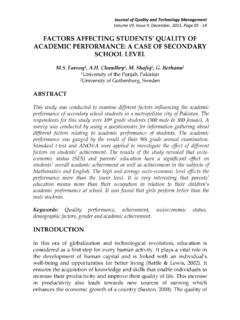




![nÁ0` h]´ VP h^ÄE°h´ÅÊQ⌦µh^˨½ DÅ⌦En¨½ À¹ ÌÄjÅ⌦ÊPÅj {´Ì](/cache/preview/7/8/7/0/6/2/b/7/thumb-787062b7e87e0e8e4ae0396a2098f16c.jpg)

